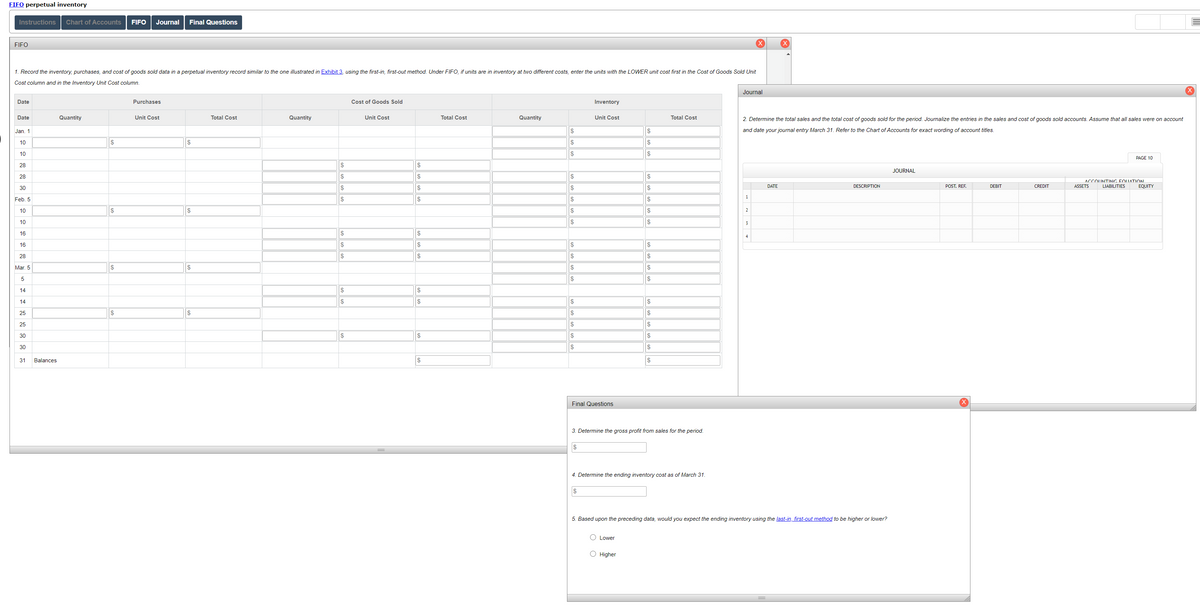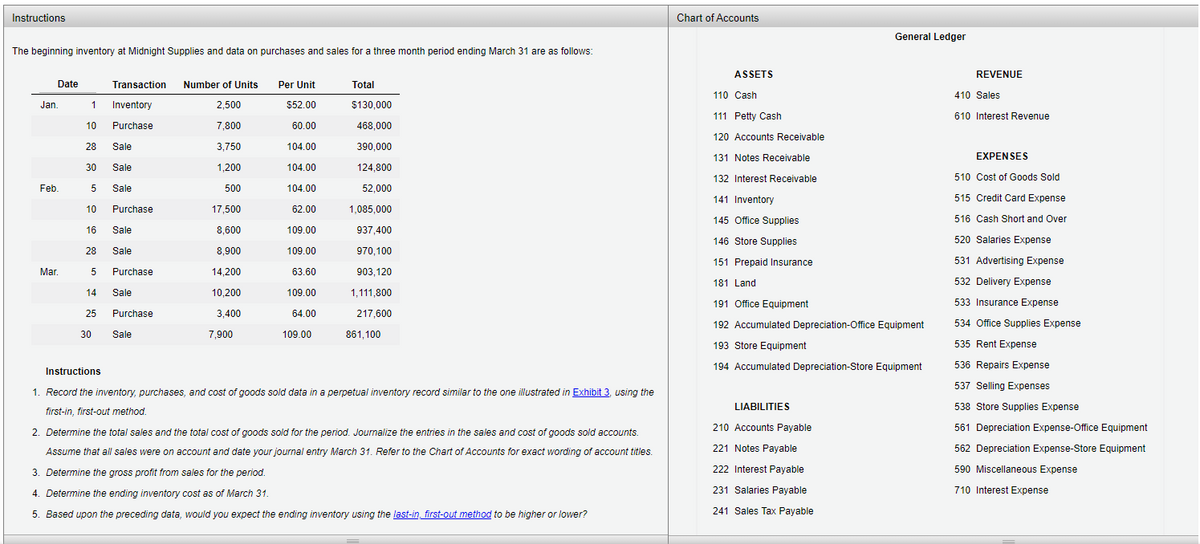The beginning inventory at Midnight Supplies and data on purchases and sales for a three month period ending March 31 are as follows. Complete the instructions. Instructions 1. Record the inventory, purchases, and cost of goods sold data in a perpetual inventory record similar to the one illustrated in Exhibit 3, using the first-in, first-out method. 2. Determine the total sales and the total cost of goods sold for the period. Journalize the entries in the sales and cost of goods sold accounts. Assume that all sales were on account and date your journal entry March 31. Refer to the Chart of Accounts for exact wording of account titles. 3. Determine the gross profit from sales for the period.
The beginning inventory at Midnight Supplies and data on purchases and sales for a three month period ending March 31 are as follows. Complete the instructions. Instructions 1. Record the inventory, purchases, and cost of goods sold data in a perpetual inventory record similar to the one illustrated in Exhibit 3, using the first-in, first-out method. 2. Determine the total sales and the total cost of goods sold for the period. Journalize the entries in the sales and cost of goods sold accounts. Assume that all sales were on account and date your journal entry March 31. Refer to the Chart of Accounts for exact wording of account titles. 3. Determine the gross profit from sales for the period.
Financial And Managerial Accounting
15th Edition
ISBN:9781337902663
Author:WARREN, Carl S.
Publisher:WARREN, Carl S.
Chapter6: Inventories
Section: Chapter Questions
Problem 1PB: FIFO perpetual inventory The beginning inventory at Dunne Co. and data on purchases and sales for a...
Related questions
Topic Video
Question
The beginning inventory at Midnight Supplies and data on purchases and sales for a three month period ending March 31 are as follows. Complete the instructions.
| Instructions | |
| 1. | Record the inventory, purchases, and cost of goods sold data in a perpetual inventory record similar to the one illustrated in Exhibit 3, using the first-in, first-out method. |
| 2. | Determine the total sales and the total cost of goods sold for the period. Journalize the entries in the sales and cost of goods sold accounts. Assume that all sales were on account and date your |
| 3. | Determine the gross profit from sales for the period. |
| 4. | Determine the ending inventory cost as of March 31. |
| 5. | Based upon the preceding data, would you expect the ending inventory using the last-in, first-out method to be higher or lower? |

Transcribed Image Text:FIFO perpetual inventory
Instructions
Chart of Accounts
FIFO
Journal
Final Questions
FIFO
1. Record the inventory, purchases, and cost of goods sold data in a perpetual inventory record similar to the one illustrated in Exhibit 3, using the first-in, first-out method. Under FIFO, if units are in inventory at two different costs, enter the units with the LOWER unit cost first in the Cost of Goods Sold Unit
Cost column and in the Inventory Unit Cost column.
Journal
Date
Purchases
Cost of Goods Sold
Inventory
Date
Quantity
Unit Cost
Total Cost
Quantity
Unit Cost
Total Cost
Quantity
Unit Cost
Total Cost
2. Determine the total sales and the total cost of goods sold for the period. Journalize the entries in the sales and cost of goods sold accounts. Assume that all sales were on account
Jan. 1
$
$
and date your journal entry March 31. Refer to the Chart of Accounts for exact wording of account titles.
10
$
2$
$
$
10
$
$
PAGE 10
28
JOURNAL
28
$
$
$
ACCOUNTING FOUATION
30
$
$
$
$
DATE
DESCRIPTION
POST. REF.
DEBIT
CREDIT
ASSETS
LIABILITIES
EQUITY
1
Feb. 5
$
$
$
$
10
$
$
2
10
$
3
16
2$
4
16
$
2$
$
$
28
$
$
$
Mar. 5
2$
2$
$
$
$
$
14
$
2$
14
$
$
$
$
25
2$
2$
$
25
$
$
30
$
$
$
$
30
$
$
31
Balances
$
Final Questions
3. Determine the gross profit from sales for the period.
24
4. Determine the ending inventory cost as of March 31.
5. Based upon the preceding data, would you expect the ending inventory using the last-in, first-out method to be higher or lower?
O Lower
O Higher
%24

Transcribed Image Text:Instructions
Chart of Accounts
General Ledger
The beginning inventory at Midnight Supplies and data on purchases and sales for a three month period ending March 31 are as follows:
ASSETS
REVENUE
Date
Transaction Number of Units
Per Unit
Total
110 Cash
410 Sales
1 Inventory
$130,000
Jan.
2,500
$52.00
111 Petty Cash
610 Interest Revenue
10
Purchase
7,800
60.00
468,000
120 Accounts Receivable
28
Sale
3,750
104.00
390,000
131 Notes Receivable
EXPENSES
30
Sale
1,200
104.00
124,800
132 Interest Receivable
510 Cost of Goods Sold
Feb.
Sale
500
104.00
52,000
141 Inventory
515 Credit Card Expense
10
Purchase
17,500
62.00
1,085,000
145 Office Supplies
516 Cash Short and Over
16
Sale
8,600
109.00
937,400
146 Store Supplies
520 Salaries Expense
28
Sale
8,900
109.00
970,100
151 Prepaid Insurance
531 Advertising Expense
Mar.
5
Purchase
14,200
63.60
903,120
181 Land
532 Delivery Expense
14
Sale
10,200
109.00
1,111,800
191 Office Equipment
533 Insurance Expense
25
Purchase
3,400
64.00
217,600
192 Accumulated Depreciation-Office Equipment
534 Office Supplies Expense
30
Sale
7,900
109.00
861,100
193 Store Equipment
535 Rent Expense
194 Accumulated Depreciation-Store Equipment
536 Repairs Expense
Instructions
537 Selling Expenses
1. Record the inventory, purchases, and cost of goods sold data in a perpetual inventory record similar to the one illustrated in Exhibit 3, using the
LIABILITIES
538 Store Supplies Expense
first-in, first-out method.
2. Determine the total sales and the total cost of goods sold for the period. Journalize the entries in the sales and cost of goods sold accounts.
210 Accounts Payable
561 Depreciation Expense-Office Equipment
Assume that all sales were on account and date your journal entry March 31. Refer to the Chart of Accounts for exact wording of account titles.
221 Notes Payable
562 Depreciation Expense-Store Equipment
3. Determine the gross profit from sales for the period.
222 Interest Payable
590 Miscellaneous Expense
4. Determine the ending inventory cost as of March 31.
231 Salaries Payable
710 Interest Expense
5. Based upon the preceding data, would you expect the ending inventory using the last-in, first-out method to be higher or lower?
241 Sales Tax Payable
Expert Solution
This question has been solved!
Explore an expertly crafted, step-by-step solution for a thorough understanding of key concepts.
This is a popular solution!
Trending now
This is a popular solution!
Step by step
Solved in 4 steps with 3 images

Knowledge Booster
Learn more about
Need a deep-dive on the concept behind this application? Look no further. Learn more about this topic, accounting and related others by exploring similar questions and additional content below.Recommended textbooks for you

Financial And Managerial Accounting
Accounting
ISBN:
9781337902663
Author:
WARREN, Carl S.
Publisher:
Cengage Learning,

Financial Accounting
Accounting
ISBN:
9781305088436
Author:
Carl Warren, Jim Reeve, Jonathan Duchac
Publisher:
Cengage Learning

Survey of Accounting (Accounting I)
Accounting
ISBN:
9781305961883
Author:
Carl Warren
Publisher:
Cengage Learning

Financial And Managerial Accounting
Accounting
ISBN:
9781337902663
Author:
WARREN, Carl S.
Publisher:
Cengage Learning,

Financial Accounting
Accounting
ISBN:
9781305088436
Author:
Carl Warren, Jim Reeve, Jonathan Duchac
Publisher:
Cengage Learning

Survey of Accounting (Accounting I)
Accounting
ISBN:
9781305961883
Author:
Carl Warren
Publisher:
Cengage Learning

Financial Accounting
Accounting
ISBN:
9781337272124
Author:
Carl Warren, James M. Reeve, Jonathan Duchac
Publisher:
Cengage Learning

Principles of Accounting Volume 1
Accounting
ISBN:
9781947172685
Author:
OpenStax
Publisher:
OpenStax College

College Accounting, Chapters 1-27
Accounting
ISBN:
9781337794756
Author:
HEINTZ, James A.
Publisher:
Cengage Learning,